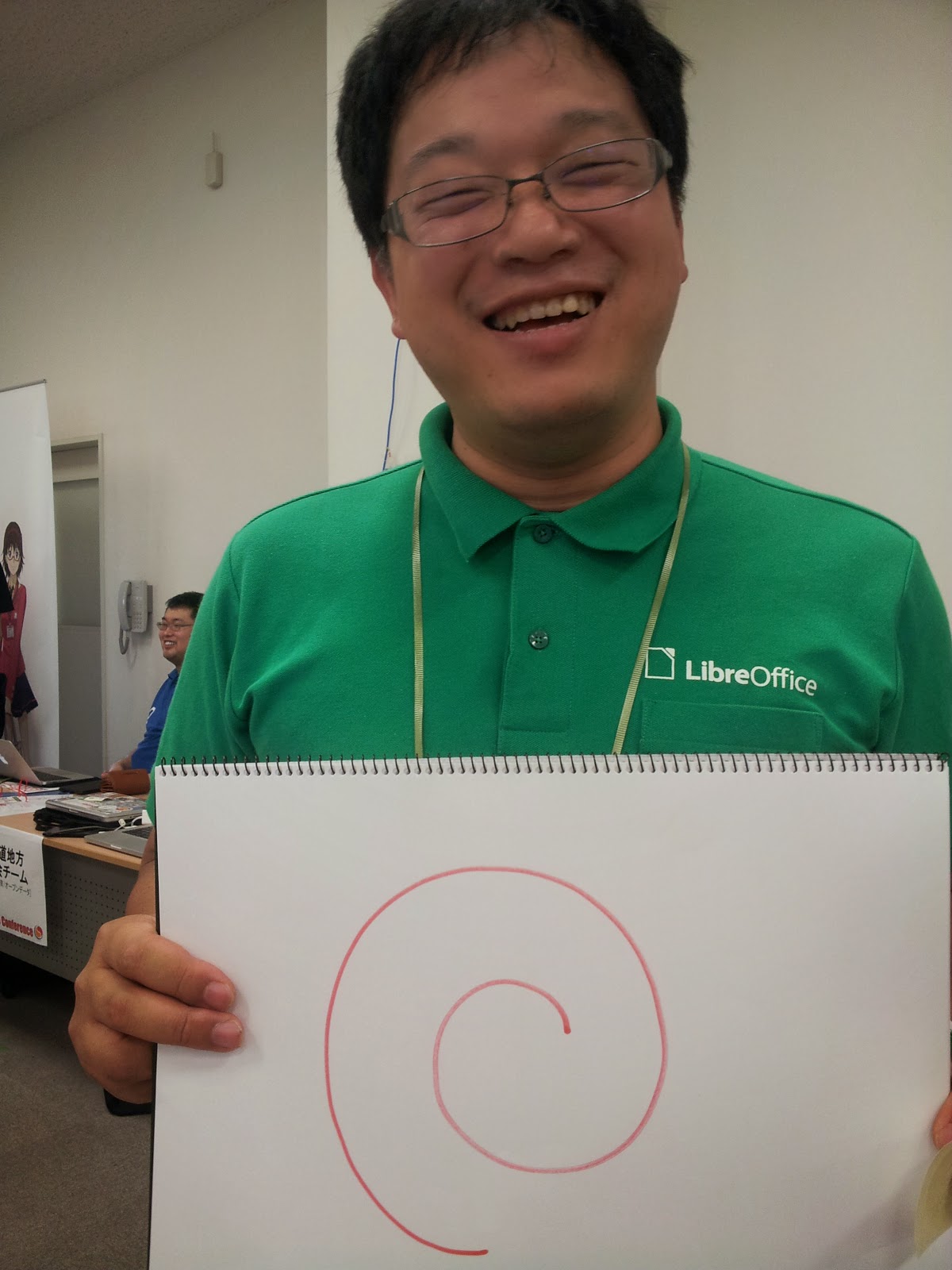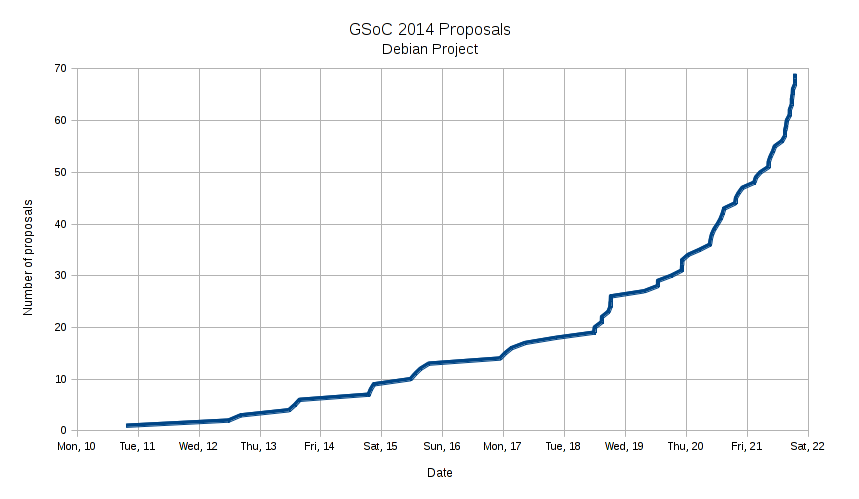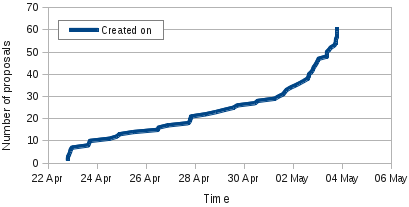
When I installed
Debian on my MacBookAir4,1 in 2012, there was no way
to do it without manual intervention yet. I followed
a tutorial on how to boot
GRUB from the
EFI Boot option
in the MacBook EFI Menu. I did not want to fiddle
with
rEFIt, and I didn't want to boot GRUB by default.
When I want to boot Linux, I press the
Option key during power up
and select
EFI Boot from the Apple boot menu.
Unfortunately, I neglected to collect notes about how I
did it manually. However, Linux 3.2 is getting a bit old, so I
finally wanted to replace my manual boot configuration
with something handled by the package system.
In case you don't have
/boot/efi in
/etc/fstab yet,
you need to mount
/dev/sda1 on
/boot/efi for the following to work.
The documentation I found on the net suggested to just
reinstall
grub-efi-amd64 and everything should work.
That is not quite true. When I do
# apt-get install --reinstall grub-efi-amd64
Nothing changes in
/boot/efi.
I sort of expected that
/boot/efi/EFI/debian would be
created, and the EFI image should be placed in there. However,
that did not happen. Why is that?
It turns out that when I installed
grub-efi-amd64 manually in 2012, I
created
/boot/efi/EFI/boot/bootx64.efi which is the EFI fallback location,
and apparently exactly what I want on this MacBook which does not support
multiple boot options.
Matthew Garrett posted an interesting article called
Booting with EFI which sheds light on this issue, go and read it.
Looking at
/var/lib/dpkg/info/grub-efi-amd64.postinst revealed
that
/boot/efi/EFI/debian needs to be created manually first.
If this directory does not exist,
grub-efi-amd64 basically
does nothing on reinstall.
Running
grub-install will actually create a new EFI image.
However, it is being created in the wrong place for this machine.
# grub-install --target=x86_64-efi
does the trick. Now
/boot/efi/EFI/debian/grubx64.efi gets
created. However, since I don't want to make GRUB the default,
there is yet another manual step to do:
# cp /boot/efi/EFI/debian/grubx64.efi /boot/efi/EFI/boot/bootx64.efi
Now I can select
EFI Boot after pressing the
Option key during
startup. GRUB is loaded and Linux 3.13 gets booted. Strike!
Looking more closely reveals that there is actually a way to
tell
grub-install that it should install to
the fallback location directly. The
--removable option does that.
For the faint of heart, what does
grub-install actually do
on an EFI system? It does not directly write to the disk, therefore
it does not need a device specified. It looks for files in
/boot/efi and assumes the EFI partition is mounted there.
So for my use case, the correct way to upgrade to a current GRUB EFI image
should have been:
# grub-install --removable --target=x86_64-efi
Meanwhile I've been made aware of
Bug#708430.
I guess it would be nice to have an option in
/etc/default/grub
which would indicate that installation to the fallback location
is desired. While this is a rather ugly hack to work around a stupid
limitation, it is still what I'd like on this MacBook. At least
since I don't have a triplle boot situation. Fallback location works
fine with just two OSes coexisting.
 It has been one week since I m back from DebConf14 and I m still recovering and catching up with things. DebConf14 has been amazing, it has been great to be back after missing it for two years. Thanks a lot to everybody who helped to make it real. On my side, I helped a bit in the talks team.
During DebConf14, I got the opportunity to discuss with Rene Mayorga about the MIA work-flow and we also got some feedback in the MIA BoF. We have plenty of ideas to implement and we re aiming to improve things during this next year.
This summer has been also 10 years since I started contributing to Debian. It s hard to believe. Ten years ago I barely knew where to start helping and now I have an endless TODO list of things I would like to do. And always during DebConf this list seems to grow ten times faster than usual. Thankfully, also motivation increases a lot :)
It has been one week since I m back from DebConf14 and I m still recovering and catching up with things. DebConf14 has been amazing, it has been great to be back after missing it for two years. Thanks a lot to everybody who helped to make it real. On my side, I helped a bit in the talks team.
During DebConf14, I got the opportunity to discuss with Rene Mayorga about the MIA work-flow and we also got some feedback in the MIA BoF. We have plenty of ideas to implement and we re aiming to improve things during this next year.
This summer has been also 10 years since I started contributing to Debian. It s hard to believe. Ten years ago I barely knew where to start helping and now I have an endless TODO list of things I would like to do. And always during DebConf this list seems to grow ten times faster than usual. Thankfully, also motivation increases a lot :)

 This is my monthly summary of my free software related activities. If you re among the people who
This is my monthly summary of my free software related activities. If you re among the people who  My recently accepted Licentiate Thesis, which I
My recently accepted Licentiate Thesis, which I

 Finally I find the mood to do this, a process which started 5 years ago in
Finally I find the mood to do this, a process which started 5 years ago in  In short: I love my MacBook Air. It is the best (laptop) hardware
I ever owned. I have seen hardware which was much more flaky
in the past. I can set the display backlight to zero via software,
which saves me a lot of battery life and also offers a bit
of anti-spy-acroos-my-shoulder support. WLAN and bluetooth work nicely.
And I just love the form-factor and the touch-feeling of the hardware.
I even had the bag I use to carry my braille display
modified so that the Air just fits in.
I can't say how it behaves with X11. Given how flaky accessibility
with graphical desktops on Linux is, I have still not made
the switch. My MacBookAir is my perfect mobile terminal, I LOVE it.
I am sort of surprised about the recent rant of
In short: I love my MacBook Air. It is the best (laptop) hardware
I ever owned. I have seen hardware which was much more flaky
in the past. I can set the display backlight to zero via software,
which saves me a lot of battery life and also offers a bit
of anti-spy-acroos-my-shoulder support. WLAN and bluetooth work nicely.
And I just love the form-factor and the touch-feeling of the hardware.
I even had the bag I use to carry my braille display
modified so that the Air just fits in.
I can't say how it behaves with X11. Given how flaky accessibility
with graphical desktops on Linux is, I have still not made
the switch. My MacBookAir is my perfect mobile terminal, I LOVE it.
I am sort of surprised about the recent rant of 












 Maybe someone else is using iDataPlex HW, so this might come in helpful...
TL, DR: Dear Hardware Vendors! Please don't force people to use specific Linux distributions when a simple unzip command would do the same.
At work we run (amongst others) an HPC system consisting of 120
Maybe someone else is using iDataPlex HW, so this might come in helpful...
TL, DR: Dear Hardware Vendors! Please don't force people to use specific Linux distributions when a simple unzip command would do the same.
At work we run (amongst others) an HPC system consisting of 120 
 The GSoC student application period is over, and the last two days were pretty interesting.
For a few years now,
The GSoC student application period is over, and the last two days were pretty interesting.
For a few years now, 
 First step will be getting a NetBSD ISO image for installation
purpose. It can be downloaded from
First step will be getting a NetBSD ISO image for installation
purpose. It can be downloaded from  Today I've made the 0.15 release of
Today I've made the 0.15 release of 
 Ana
Ana  na ir slavena ne tikai ar savu akmens m ri valsts zieme os, bat ar ar Di o nas Ugunsm ri apk rt visam s valsts Internetam, kas blo visu p c k rtas un iebremzina visu p r jo. Man pirm person g saskarsme ar o pakalpojumu notika jau anhajas lidost , kad tri vien izr d j s, ka valst blo ts ir ne tikai Facebook, bet ar Twitter, kas iev rojami apgr tin ja manas iesp jas tri un viegli apzi ot visus, ka es esmu v l joproj m esmu dz vs un vesels. P c p ris eksperimentiem izr d j s, ka, lai ar no telefona nav pieejama Google+ m jas lapa un nav lejupl d jama Google+ (un WhatsApp) programma uz Android, tom r, ja t s jau ir telefon , ie abi servisi turpina no telefona str d t. T p c es s ku rakst t ce ojuma piez mes Google+ un da as dienas p c ce ojuma s kuma man pat izdev s nokonfigur t
na ir slavena ne tikai ar savu akmens m ri valsts zieme os, bat ar ar Di o nas Ugunsm ri apk rt visam s valsts Internetam, kas blo visu p c k rtas un iebremzina visu p r jo. Man pirm person g saskarsme ar o pakalpojumu notika jau anhajas lidost , kad tri vien izr d j s, ka valst blo ts ir ne tikai Facebook, bet ar Twitter, kas iev rojami apgr tin ja manas iesp jas tri un viegli apzi ot visus, ka es esmu v l joproj m esmu dz vs un vesels. P c p ris eksperimentiem izr d j s, ka, lai ar no telefona nav pieejama Google+ m jas lapa un nav lejupl d jama Google+ (un WhatsApp) programma uz Android, tom r, ja t s jau ir telefon , ie abi servisi turpina no telefona str d t. T p c es s ku rakst t ce ojuma piez mes Google+ un da as dienas p c ce ojuma s kuma man pat izdev s nokonfigur t